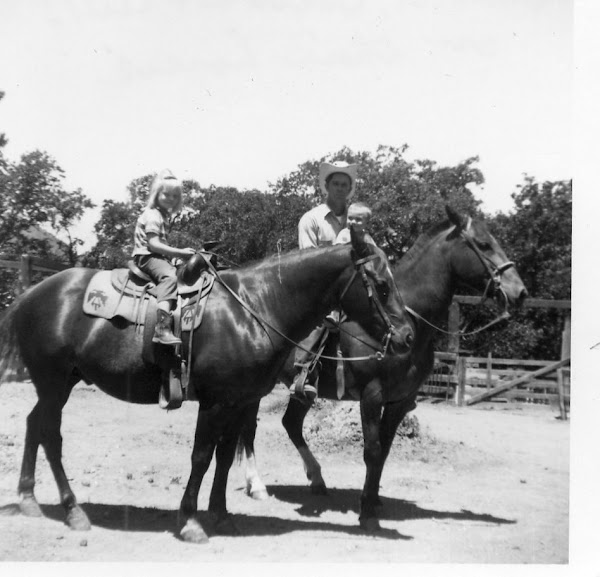The Stirrup
"My foot's in the stirrup, my bridle's in my hand,
Good morning, young lady, my hoss he won't stand.
Old Paint's a good pony, he paces when he can,
Goodbye ol' Paint, I'm leaving Cheyenne."
" Good bye Old Paint "
It's just a simple tool really. A piece of wood or iron formed into a shape, hung by a strap to a saddle. And yet, that simple thing changed the entire world.
I imagine it like this:
Early man climbed out of the caves, took one look at Horse and said to his friend,
" Hold my beer. I want to try something."
Loaded down with rocks and sticks, it must have been difficult to get up on the horses back; he needed a step. He needed a step that could go where he went while on the horse, so he would always be able to mount up.
Man developed a single loop, attached to the girth of the saddle. He could hook a big toe in and haul himself up.
As most horsemen know, being barefooted around a horse is Numero Uno No-No. Like in the game Rock/Paper/Scissors, Horse Hoof crushes People Toes.
Men began wearing sandals, and developed a single 'step' attached by a strap to the saddle.
That worked for awhile, but it needed some improvement.
The next stirrup was elongated and the sides were removed to keep the riders foot from being entangled.
Soon men figured out that when they were riding the horses around looking for War, the foot with the step could rest, while the other foot grew tired. They had to get off the horse to rest. They couldn't go as far, ride as long or fight as well.
Qin Shi Huangdi's Army, Terra Cotta or otherwise, did not have stirrups.
Either did the Early Romans.
Of course they didn't have gun powder either, but I digress.
Enter the paired stirrup.
 |
| Jin Dynasty stirrups |
The nomad Mongolians came to realize that it improved your center of balance to have two stirrups. Not only that, but it gave you a better purchase when swinging a sword.
 |
| Traditional Mongolian riding saddle. |
The whole idea caught fire and spread through South Central Europe. German raiders improved the stirrup by building in a rectangular loop set in the same plane as the bow. Viking raiders most likely brought the stirrup into Scandanavia.
 |
| Viking raiders more than likely spread the use of the stirrup into Scandinavia. |
The Early Hungarians improved the shape from a 'slipper' into a pear or apple shape.
About this time they may have also decided that a boot was way better than a sandal for riding.
 |
| Pear shaped iron stirrup. |
Crusaders garbed in heavy iron armor needed a larger stirrup to help hold their weight. Their style of riding soon swept the entire European continent.
 |
| Crusaders popularized the metal wide bottom stirrup,especially for war. |
Japan improved the stirrup during the Edo Period making the bottom flat, and covering the wood with iron.
 |
| Decorated Japanese stirrup. |
All the while the movement of Man across the continent was supported by the lowly stirrup.
When people began to cross the Ocean, they brought their horses and saddles with them.
Spanish Conquistadors fitted their saddles with stirrups that had covers over the toes. It had a two fold effect, it protected the feet and boots from getting wet or being hung up in thick brush while cutting new trails. Plus it looked cool.
The Spanish settlers into Western America devised a better stirrup, built on that model. The Western tapadero covered the stirrup, and was often lined in fur or leather to keep your feet warmer, as well as keeping your boots from slipping through the stirrup if riding a wilder bronc.
 |
| Bohlin Parade Saddle with fancy tapaderos at The Autry Museum, Los Angeles Ca. |
 |
| Modern pair of tapadero covered stirrups with hand stamped basket weave toes and floral design. |
As with anything else, the stirrup is also dictated by fashion, and no more so than today.
The typical English style stirrup, called the irons, are polished chrome, but even they have been decorated with rhinestones and etching.
 |
| Rhinestone embellished English type stirrups. |
 |
| Etched chrome English style stirrups. |
Western stirrups have the most variations now.
 |
| Bell shaped western stirrup with wide flat foot. |
 |
| Etched aluminium western stirrup, with a slight bend in the arch to relieve foot pressure for the rider. |
 |
| Lightweight metal Trail stirrups with 'cage' tapaderos. |
 |
| Vintage leather western tapaderos with silver diamond embellishment. |
 |
| Vintage iron stirrups. |
 |
| Vintage Mexican style Vaquero stirrups. |
 |
| 'Monkey face' Mexican tapaderos over wooden stirrups. |
 |
| Spanish inspired Paso stirrups of hammered metal. They can also be used as an anchor when you leave your horse unattended. |
 |
| Vintage English ladies side saddle stirrup. There was ever only one, as the other foot was draped over the leaping horn. |
Bell, Ox Bow, reining, roping, and trail riding, with tapaderos or without. Some have rhinestones, etched aluminium or engraved leather.
 |
| Modern Western Pleasure Saddle with leather covered stirrups. |
The lowly stirrup, the thing that changed the world, has left the function of war behind and is now firmly in the heart of fashion.




























